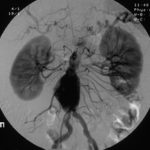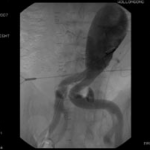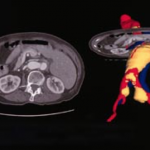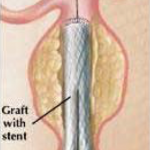Aneurysmal Disease (AAA, TAAA, Popliteal Aneurysm, etc)
What is an Abdominal Aortic Aneurysm, or AAA?
Abdominal aortic aneurysms (AAA) are caused by progressive weakening of the aortic wall that causes a “ballooning” of the vessel. The aneurysm will grow larger and is likely to rupture if it is not diagnosed and treated. Aneurysms occur most often in the aorta, the main artery of the chest and abdomen. The aorta carries blood from the heart to all parts of the body including the vital organs and the legs and feet.
Ruptured aneurysms are the 10th leading cause of death in men over 50. A ruptured aneurysm (where the aorta has torn and is bleeding into the abdomen) is an emergency and procedures must take place immediately to save one’s life and avoid serious complications.What causes an AAA?
What Causes an AAA?
Proteins in the wall of the aorta, called elastin and collagen provide strength and flexibility to this large artery. This is similar to muscles and tendons providing strength to the arms and legs. Aneurysms are caused by a progressive breakdown of these proteins that lead to a weakness in the wall of the aorta which can then steadily expand like a balloon. These proteins, collagen and elastin, may gradually deteriorate with age. In rare cases an aneurysm may be caused by infection. There is still much to be learned about the cause of aneurysms and their growth. Risk Factors for Abdominal Aortic Aneurysm (AAA)
Risks Include:
- Age over 60 years
- Family history of AAA especially in males
- Smoking
- High blood pressure (hypertension)
The risk of AAA increases with age. AAAs are between five to ten times more common in men than in women. Tobacco users are eight times more likely to be affected than non-users.
How is AAA Diagnosed?
Although AAA can be detected by physical examination, most are diagnosed today using an ultrasound scan or CAT scan. These are simple, non-invasive exams conducted on an outpatient basis. These exams also measure the size of AAA – a key element in determining the best treatment. When aortic aneurysms are diagnosed early, treatment is safe and effective and the aneurysm is curable. Aneurysms are often detected while performing tests for entirely different reasons. Most patients have no symptoms unless the aneurysm ruptures so, if you are at risk, it is important to discuss AAA with your doctor.
AAA Treatment Options
If the AAA is larger than 5-6 centimetres in diameter (about the size of a lemon), it will require treatment. Your physician’s decision to repair will be based on the risk of the aneurysm rupturing, along with surgical or procedure risks, and risks associated with other pre-existing conditions. Smaller aneurysms that cause back or abdominal pain may also need treatment, especially for those that are enlarging rapidly. The aneurysm can be treated with open surgery or endovascular techniques.
Finally…
This website should have answered some of your questions, but remember that this is only a starting point for discussion about your treatment with the doctors looking after you.



